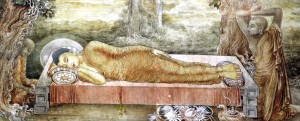Maha Parinibbana– The passing away of Lord Buddha on a full moon night
The thrice blessed day, the birth, Supreme Enlightenment and passing away (parinibbana) of the Buddha is in the month of May (Vaisak).

A painting at the Kelaniya Temple depicting the Parinibbana
It is remarkable that all three important events in the Buddha’s life happened under trees. Prince Siddhartha was born in the shade of a Sal tree in Lumbini, attained Enlightenment under the Bodhi tree in Gaya and passed away (parinibbana) between two Sal trees in Kusinara close to the kingdom of Mallas. Even his first sermon to the five ascetics was under a tree in the deer park.
Buddha was no God, nor a mythological figure. He was a human being, a man, a prince. The Buddha is no more, yet even after 2500 years, the Buddha’s doctrine the Dhamma is still alive. A stanza (gatha) speaks of the virtues of the Buddha (Budhuguna) which has nine qualities – Iti piso, Bhagava, Arahan, Samma Sambuddho, Vijja-carana-sampanno, Sugatho, Loka-vidu, Anuttaro, Purisa dhamma-sarathi, Satta-deva-manussanan, Buddho, Bhagavati.
The core teaching of the Buddha is the Four Noble Truths – Dukkha (suffering), Samudaya (arising of suffering), Nirodha (cessation of suffering) and Magga (path leading to the cessation of suffering).
For 45 years the Buddha taught and dispensed his knowledge. He was now eighty years. Although tired and spent, his mind was strong and alert.
The Maha Parinibbana Sutta explains all the events that took place during the last few months of the Buddha’s life.
Three months prior to his parinibbana (passing away) he knew his life was coming to an end and prepared for his final journey.
The Buddha desired to spend his last days at the foothills of the snow-capped Himalayas, away from the big cities. He always journeyed by foot with his group the bhikkhus. It was a long journey through many cities and villages, which he started from Rajagaha.
The Buddha was at Vesali. He went to Beluva during the rainy season. Here, he became very sick and was in great pain and agony. With his sheer determination and with the power of his mind, he endured the pain. When he was feeling better, he spoke to Venerable Ananda saying “be your own refuge. Hold fast to the Dhamma as a refuge. Resort to no other refuge…”
His journey took him to Mahava. Addressing the bhikkhus, he requested them to practise the Dhamma and spread it to the world.
On his way, he met Cunda the goldsmith who listened to the Buddha’s sermon. Next day he was invited by Cunda and offered food. This was the Buddha’s last meal. When Buddha ate this food he fell ill again which was more serious than before. Controlling the pain he continued to journey to Kusinara. He took rest along the way and finally approached Kusinara. He met Pukkusa, a disciple of the sage Alara-kalama. Having listened to the Buddha he became a refuge in the Buddha, Dhamma and Sangha and presented the Buddha with two rolls of gold coloured cloth. One role was accepted by the Buddha and the other was offered to Ven. Ananda by Pukkusa.
Crossing the Kakuttha River the Buddha arrived at Hiranyavati River within the boundaries of Kusinara. Crossing the river with his group of bhikkhus, Buddha arrived at the Sal Grove of the Mallas – his last stop.
The Buddha was weary. He requested Ven. Ananda to prepare a couch between two Sal trees as he wished to lie down. Ven. Ananda took a robe and folding it in four placed it on the couch. The Buddha lay down on his side with his head towards the north. Ven. Ananda knew that the Buddha was about to leave this world. His grief knew no end. He left the Buddha to be by himself and wept, lamenting “unlike other bhikkhus, I have not yet attained the state of Arahant.” He was worried that he will not have his teacher to guide him further.
Buddha, failing to see the Ven. Ananda inquired from the bhikkhus as to where he had gone. They replied that he was weeping as he had still not attained the stage of Arahant. Ven Ananda was brought to the Buddha’s presence and to console him the Buddha praised Ven. Ananada for the good work he had done.
Meanwhile, Subadda a wondering ascetic, to clear his mind of certain doubts approached Ven. Ananda requesting to see the Buddha. Ven. Ananda did not wish to disturb the Buddha and rejected his request. Hearing the conversation, the Buddha requested Ven. Ananda to permit Subhadda to see him. His problems were solved and Subhadda became the last bhikkhu to be converted by the Buddha.
Buddha finally gave an opportunity to the bhikkhus to raise questions to clear any doubts about the Dhamma. But all were silent. For the last time, Buddha addressed the bhikkhus saying “All actions and deeds are transient and you must detach yourself from them completely.”
Then, the Buddha entered Samadhi entering the jhanas and in the last watch of the night passed away, (entered the Maha parinibbana) on the full moon day of the month of May (Vaisak), in the Sal Grove of the Mallas, near Kusinara.


